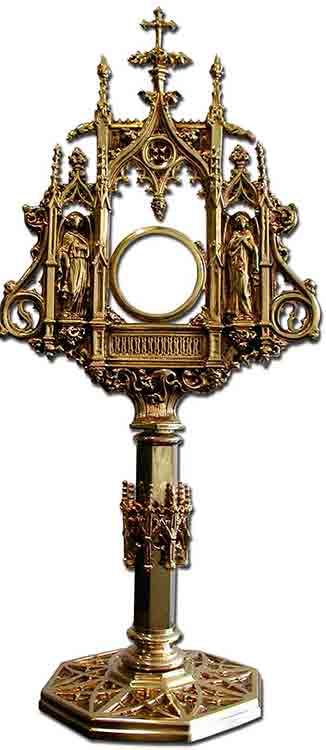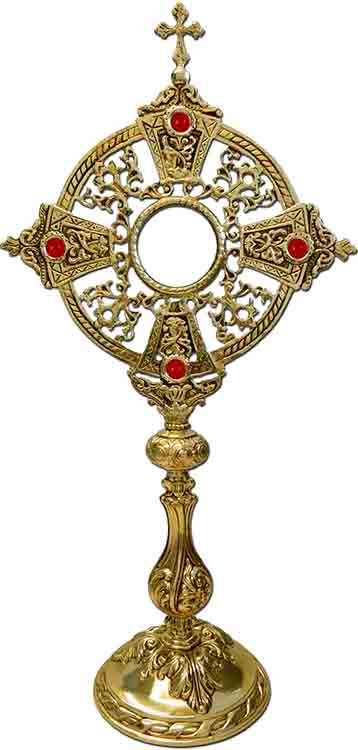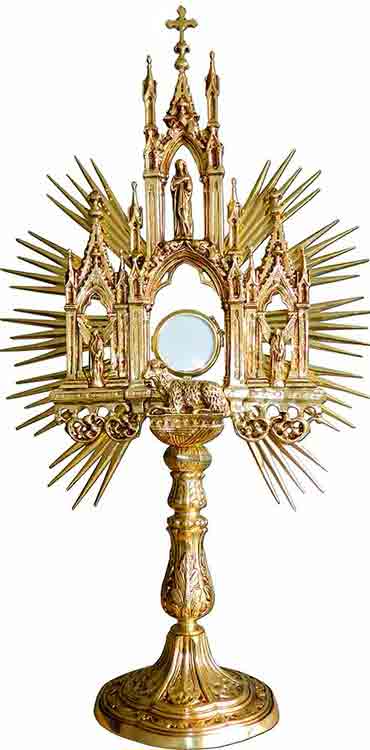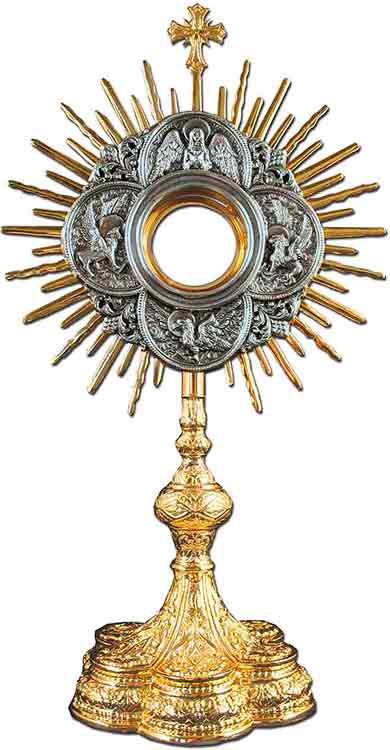
Custody for the Blessed Sacrament | religious monstrances
Religious monstrances for the Holy Eucharist
There is a wide variety of religious articles for Corpus . Among them, it is worth highlighting the role played by religious monstrances.
The processional monstrances are containers for the Host, the Blessed Sacrament, Jesus in the Blessed Sacrament. The role of the monstrances is especially relevant in the Catholic Church in the celebration of the feast of Corpus Christi.
The origin of the use of the monstrances as exhibitors of the Blessed Sacrament during the Corpus Christi processions must be sought in the very origin of the celebration of this religious festival. According to some authors, custody can be identified with the monstrance or ostensorium (from the Latin ostentāre, "to show"). Other sources differentiate the custody of the monstrance based on the complexity and size of the piece.
Be that as it may, both pieces of Eucharistic goldsmithing are sacred receptacles whose function is to house or deposit the Host, Eucharist, the Blessed Sacrament. In this way, Jesús Sacramento is exposed to the faithful in moments of adoration (Exposition of the Blessed Sacrament) and during the Eucharistic processions of Corpus Christi.
There is a wide variety of sizes, styles and materials in religious monstrances. Generally around the Eucharist rays are represented that symbolize the graces conferred on those who adore. Despite this wide variety, they all have in common that they have a golden crescent or a virile, where the Blessed Sacrament is deposited.
The monstrances for the Holy Eucharist are a throne of glory for Jesus the Sacrament, so they try to make it worthy and beautiful.
Custody of the Blessed Sacrament, history and evolution
Monstrances or religious monstrances have their origin in the institution of the festival called Corpus Christi in the middle of the 13th century. At that time the custom of exposing the Blessed Sacrament to the view of the faithful is introduced. For the exhibition, in these first years of the primitive Catholic Church, glass provided with glass is used. It is probable that at first all kinds of religious objects were used to display the Blessed Sacrament: images, crosses, reliquaries, ciboriums and pyxes. Despite this, the need was soon felt to build vessels specially designed for such an exhibition of Jesus in the Blessed Sacrament.
Even taking into account the aforementioned, it is very strange to find documentation on the existence of monstrances for the Blessed Sacrament before the 14th century with the characteristics with which we currently know them. In this century, when the elaboration of religious monstrances experiences a great impulse motivated by the institution of the Corpus Christi procession, which is generalized and solemnized.
Towards the end of the 14th century there is already abundant documentation on processional monstrances of the Blessed Sacrament. They are described as religious goldsmith articles of various types and shapes. Among the oldest, the Eucharistic monstrances in the Gothic style stand out. Gothic religious monstrances are usually forged in the form of a polygonal tower and peak, with small glass windows. Good examples of this style are the Eucharistic monstrances of Bari and Molfetta. Other religious monstrances were made up of images of the Virgin with the Child Jesus or of Christ, who placed the Blessed Sacrament on his chest or forehead, inside a glass.
From the middle of the 15th century, the religious monstrances take the form of a turret or ogival temple (almost always made of silver) bristling with pinnacles. The monstrances were generally supported by an artistic base, leaving a silver or gold lunula or virile in the middle to visibly place the Body of Jesus in the Blessed Sacrament.
During the 15th and 16th centuries, a competition began in many countries to possess monstrances of monumental proportions: such as the ark-monstrance of the Duomo of Genoa, a distinguished Renaissance work (1553), and which needed eight priests to be processed. Among all the monstrances and religious monstrances, those of Spain stand out, most of them over 3 meters high, of extraordinary sumptuousness and beauty.
In France and Germany, Eucharistic chapels multiplied at this time , with large monstrances visible through bars. In these chapels the faithful people could visit and contemplate the Blessed Sacrament.
In the Renaissance period, Eucharistic monstrances were also built in the form of a pavilion but in a Roman style.
Since the end of the 16th century, the ones that are most in use today began to appear. The monstrances for the Blessed Sacrament in the form of a radiant sun , which since the 18th century have had circles of little angels' heads surrounding the central virile.
Monstrances for Corpus Christi in Spain
As mentioned before, the largest and most artistic religious monstrances in the world are found in cathedrals in Spain. Among them, those of the Arfe family stand out. Enrique de Arfe is the author of what is probably the most famous, the custody of Toledo, known as the processional custody of Toledo, located in the cathedral of this city.
Enrique Arfe's grandson, Juan de Arfe , sculpted the monstrance of Ávila (with flattened forms), the monstrance of Seville (which measures more than three meters and has theology as its theme) and the monstrance of Valladolid, called "of Adam and Eve in the Garden of Eden", because it is the scene that appears in her lower body. The custody of Valenzuela (Córdoba) that stands out for its lower body and for being the oldest in the region.
Other Spanish custody to highlight:
Gothic style religious monstrances
Vich custody dating from 1413
The custody of the Baeza Cathedral made with the donations of silver cutlery from the people of Baeza after the disappearance of the previous one in a fire in the SI Cathedral of Baeza in 1691.
The custody of Barcelona with its impressive rhinestones.
The custody of Cádiz that measures four meters
The major custody of Córdoba, Gerona, León, Palma de Mallorca, Salamanca, Sahagún, Toro and Zamora.
Monstrances for the Blessed Sacrament in classical or Renaissance style
The major custody of Alarcón (Cuenca), another in Cádiz, Jaén, Palencia, Santiago, Segovia, Seville (two), Teruel, Valladolid and Zaragoza.
Baroque style Eucharistic Monstrances
The processional Monstrance of the Corpus of the Murcia Cathedral , the work of Antonio Pérez de Montalto, which is preserved and exhibited in the Cathedral Museum.
Custody of the Spikes of Ramón Bergón.
Religious custody outside of Spain
Outside of Spain, the colonial custodians of the Banco de la República Art Collection in Bogotá, Colombia are notable. One of them, popularly known as 'La Lechuga', made by José de Galaz in 1707, is adorned with 1,485 emeralds, 1 sapphire, 13 rubies, 28 diamonds, 62 baroque pearls and 168 amethysts.
Processional monstrances in Religious Articles Brabander
Among the numerous religious articles for Corpus Christi that we have in our online store, today we want to focus on the processional monstrances.
 Monstrance for style altar
Monstrance for style altar
Gothic style religious monstrance made in bronze . It measures 60 centimeters high from the base to the top of the cross. This monstrance is 17 centimeters wide. Foot formed by an octagonal base with typical decoration of the monstrances of the fifteenth century. The shaft, which goes from the foot to the virile, maintains the polygonal structure of the base and is decorated with different architectural motifs, culminating in a embossed capital with plant motifs. The virile area is formed by three windows ; a larger central decorated in its upper part by traceries characteristic of the Gothic style. The two side windows are adorned with two images. Each of the windows have columns and are topped with richly decorated capitals. The central window is topped with a cross with a double crossbar, also called an archiepiscopal cross, distinctive of archbishops and patriarchs. The abundant ornamentation characteristic of Gothic monstrances is the element that best defines this article.
 Eucharistic monstrance in bronze
Eucharistic monstrance in bronze
Monstrance for the Blessed Sacrament in baroque style made in bronze. It measures 57 centimeters high from the base to the top of the Cross. This monstrance is 31 centimeters in diameter in the circular part that surrounds the virile. Parish goldsmith's piece with a circular foot decorated with plant motifs. The shaft is adorned with a knot with plant motifs and with three rings (the largest being the one closest to the virile). The shaft is finished off with an embossed piece that supports the entire structure that surrounds the virile. The monstrance has a virile surrounded by two decorated discs that form a circle . The circle is adorned with different motifs and with a widened Greek Cross with four arms of equal length. Each of the arms of the cross contains a red stone. The monstrance is finished off at the top with a cross.
 Gothic religious monstrance with bronze powers
Gothic religious monstrance with bronze powers
Monstrance of the Blessed Sacrament in Gothic style made of metal with bronze powers . It measures 85 centimeters high from the base to the top of the Cruz. The monstrance is 50 centimeters wide from end to end of the powers. Parish goldsmith's piece with the foot formed by a circular base. The shaft maintains the circular structure of the base and is decorated with several rings and knots of different sizes. This part of the monstrance culminates with an embossed capital. The virile area is formed by three windows; a larger central one decorated on its upper part with traceries characteristic of the Gothic style . The two side windows are adorned with two images representing two angels with outstretched wings. Each of the windows is decorated with columns and topped with richly decorated spiers. The central window is linked to another window at the top where an image is located. The virile area is completed with a Cross in the upper part of the monstrance, with a lying lamb and with eight powers that complete the set. The abundant ornamentation characteristic of Gothic monstrances is the element that best defines this article.
